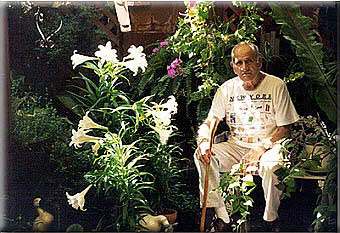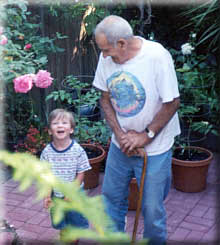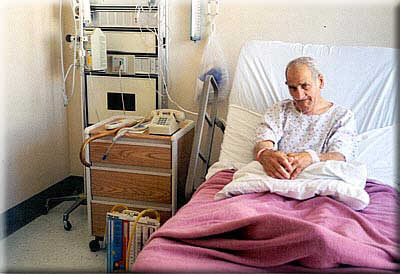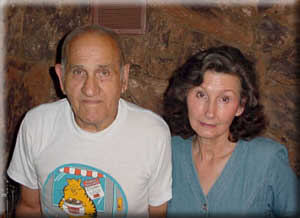Garden Of Memory: The Story Of Sam And Doris Silvestro
Still virile at the age of 74, Salvatore "Sam" Silvestro was diagnosed with right-sided malignant pleural mesothelioma on June 29, 2001. Sam and his very lovely wife Doris live in San Mateo, just a few miles from San Francisco.
Before his mesothelioma, Sam was physically robust from decades of hard work as a a mason, boilermaker and self-described "jack of all trades." He says that before his recent illness, he could still climb trees and trim bushes. As he puts it, "I could wrestle a bear."
CULTIVATING HIS GARDEN
Sam Silvestro is a charming study in contrasts. His hands are still massive from decades of hard work. He grew up poor in Mallet Creek and Cleveland, Ohio. He says you could gauge how tough a kid was by how far down the road he lived -- and Sam lived on the last, poorest house on the road.
It thus seems incongruous that these huge, gnarled hands created and tended a large and teeming garden. Sam is a self-taught and apparently highly intuitive gardener. There is a fig tree, and a grapefruit they just planted, and beautifully flowering cactii. Exotic flowers cascade over trellises. There are garden benches strategically placed for reflection. There is a fountain with a goldfish pond. Sam had to build a screen to place over the pond at night to keep the racoons out; one morning they found bits of goldfish flung about. There are numerous wind chimes, some built out of spare copper pipe by Sam, some gifts from their daughters. There is a playhouse Sam built for his daughters. Sam put up motion-sensitive lights for the deer that come from the hills and feed on his front garden at night, but Doris laughs that "the light just helps them find what they want to eat!"


The Silvestro garden is more than a place of extraordinary beauty; it is a place of memories, triggered by every plant and trinket. The Silvestros have lived in this same home for the last 38 years. Their garden is a living metaphor of marital and familial love.
BEAUTY AND THE BOILERMAKER
Sam has been married to Doris since January 14, 1949. They are proof that love, like a giant sequoia, can grow taller, bigger and stronger over time. The contrast between the two is startling. She has beautiful skin which she has shielded from the sun, and appears much younger than her age, which, being a lady of the Texas Panhandle, she mirthfully avoids stating. She is much more polished than Sam, and very sweet.
Doris and Sam dote on their only grandson, Sam. Sam's mother Joyce takes after her mother; she also looks astonishingly young for her age.
AN ENDURING SADNESS
Tears come to the Silvestros' eyes when they describe the death of their first daughter Julia at the age of eighteen. She was born with a kidney condition called hydronephrosis. Julia lived with a Foley catheter her entire life. She took her first steps holding the bag. Doris learned all that she could about the disease, and gained considerable expertise. Doris relates matter-of-factly and without pride that the doctors would tell Julia's nurses to defer to Doris' advice.
Towards the end of Julia's life, the doctors began running out of treatments for her condition, and the Silvestros were left with few treatment options. The doctors urged surgery, which the Silvestros consented to. Julia suffered massive internal hemorrhaging, rallied for a few days, relapsed to further hemorrhaging, lapsed into a coma, and then died.
This experience with Julia now resonates even more poignantly with the Silvestros. Sam's decades of asbestos exposure have brought him, like dear Julia, face-to-face with limited treatment options and risky procedures. Once again, Doris has immersed herself in medical studies in an attempt to save a loved one.

FAMILY URGES SAM TO SEE DOCTOR
Sam's troubles began in the late fall of 2000, when he became so short of breath that he could not walk down the street. He finally heeded the nagging of his wife and his daughter Joyce, and consulted with his primary physician. Sam's doctor took chest films, which revealed the presence of pleural effusions on the right side. He then referred Sam to a pulmonologist. On January 24, 2001, at Mills Peninsula Hospital in Burlingame, the pulmonologist performed a thoracentesis in the usual fashion, via eighteen gauge needle from the back, removing a little over a liter of dark, bloody fluid.
For a while, Sam felt a little better, but as he says, "the fluid came back with a vengeance." He underwent a second thoracentesis on March 13. His doctors removed almost two liters of bloody fluid. The pleural biopsy showed only skeletal muscle. However, the fluid was positive for malignant cells. The differential diagnosis included mesothelioma and adenocarcinoma, although no absolute diagnosis was made.
DOCTORS SUSPECT MESOTHELIOMA
Sam's doctor said he was "pretty sure" this was mesothelioma. He advised Sam that the next time he needs to have the fluid drained, he should undergo thoracotomy with biopsy to be absolutely certain. He went on to tell Sam that he has a terminal disease, that his cancer is advanced, and that there is no cure and no treatment.
Sam was then referred to an oncologist, who also favored the diagnosis of mesothelioma over adenocarcinoma, given the limitation of the disease to the right thoracic cavity and the presence of pleural plaques. Pleural plaques, or scar tissue of the pleura, form when needle-shaped asbestos fibers puncture the pleura.

"SLASH, BURN, AND POISON" OPTION UNWELCOMED
The oncologist recommended chemotherapy with "significant toxicities", which Sam did not want to undergo. Sam also felt that his Type II diabetes would likely limit the chemotherapies available to him. Moreover, their daughter Julia died from a desperate, emergency procedure to battle a life-long kidney ailment. The Silvestros remain traumatized from her loss, and wary of novel treatment. Instead, Sam chose to follow their doctor's further advice to "watchfully wait" and undergo exploratory thoracoscopy with biopsy and talc insufflation only if the pleural effusions returned.
EMERGENCY PARTIAL PLEURECTOMY
The pleural effusions did return as spring turned into summer, and Sam decided upon a repeat thoracentesis with pleural biopsy and talc insufflation which took place on June 27, 2001 at Mills Peninsula Hospital in nearby Burlingame. The thoracic surgeon removed over two and one-half liters of fluid. To the Silvestros' surprise, the surgeon decided after scoping Sam that he should perform a partial right pleurectomy. The surgeon said that there was a lot of "goop" in the chest cavity, and that the tumor peeled easily off the lung. He then insufflated talc into a pocket which had not been reached before.
As Sam returned to consciousness post-operatively, he sensed pain building to an excruciating level. His last thoughts before the surgery were that he was undergoing a relatively simple procedure which would relieve him of the pain of recurring pleural effusions and provide a definitive diagnosis. He expected to be in the hospital at most a couple of days. Instead, while Sam was definitively diagnosed with mesothelioma on June 29, pain and fever raged within him day after day after day. He was finally released from the hospital on the Fourth of July, but the horrible pain and fever continued.

MORPHINE FOR PAIN
Sam's doctors suspected that an adverse reaction to the talc was causing the fever and prescribed antibiotics, which eventually brought the fever down. But today, many weeks removed from surgery, Sam remains in terrible pain. His doctors have prescribed ever increasing doses of morphine to help Sam cope, but the relief is fleeting.
Sam and Doris also remain more than a little upset over the unexpected removal of part of his pleura. While they understand that physicians must often exercise their professional judgment on an emergency basis, Sam would not have consented to this procedure had it been discussed beforehand. The Silvestros hope that publication of Sam's experience will serve as a cautionary tale to others considering pleural biopsy.
It is difficult for the Silvestros to believe that Sam will ever come out of his pain, but they both hold onto hope that Sam will get better and return to tending his garden and doting on his grandson. Our thoughts and prayers are that this will be so.
*** POSTED JULY 30, 2001 ***
Mr. Silvestro passed away on November 29, 2001
Update 9/08/2006
Jury Awards $15.25 Million
Los Angeles. Almost five years after Sam passed away, his wife Doris finally had her day in court. Doris had never been to trial before or done anything like that, but she could not have been more pleased with the attorneys, the judge, and the jury.
On September 7, 2006, the jury ruled 11-1 that the two trial defendants, Kaiser Gypsum and Kelly Moore, were both negligent and strictly liable for the death of Sam Silvestro, who was a boilermaker and cement mason. The jury ruled that Sam's exposure to the dust from their joint compounds was a substantial contributing factor to the cause of his malignant mesothelioma, which eventually claimed his life. They awarded $15 million in non-economic damages, and $250,000 in economic damages. They decided that KM was 30% liable and KG was 30% liable.
The jury also determined, based on the evidence that both Kaiser Gypsum and Kelly Moore acted with malice. In other words, their conduct was unconscionable or despicable. With that finding, the jury was entitled to deliberate for a second time to award punitive damages, which are designed to punish and deter egregious misconduct.
However, the jury never got the chance. The Judge struck the jury's finding of malice, thus depriving the jury, despite their hard work and careful assessment of the evidence, of taking the next step. We spoke to several jurors afterwards. Many expressed shock that the Judge had invaded their province as fact-finders. Several indicated that they were inclined to award over $20 million in punitive damages. Others were disappointed to learn that under the law the plaintiff would only be allowed to collect 60% of the $15 million award. Had we known that, said one juror, we would have awarded much more.
Doris is relieved the case is over. Several years ago, her husband Sam passed away only a few weeks before their case was set for trial. After that, the case was reset, but the trial court struck Sam's testimony, forcing Doris to appeal the bad ruling. The appellate court agreed with Doris and her husband's deposition was deemed admissible.
Doris wants others to know about what she and Sam endured because she hopes it helps other victims. Although the wheels of justice spin slowly, she said, eventually, justice is done. She was very thankful to the jury. After the verdict was read and post trial motions were argued, several jurors lined up to hug and kiss Doris. Tears of joy flowed freely down the cheeks of Doris and several jurors.
After the trial, Doris went to lunch with the jury where they continued to discuss the matter at hand. She was so pleased to get to meet them, and said they were each such wonderful, lovely people who identified with her situation and with Sam. Afterwards, they exchanged hugs, kisses, and addresses. Doris plans to write each a note.
Even though Doris returned to a large tub of mail, on September 8, she finally felt closure. She plans to just rest for at least a day or two to recuperate after being away for so long. She feels that she can get on with what she needs to do now. Doris' "gratitude will go on forever to all those who worked so hard." She has kept her faith through everything and is now ready to return to those things in life she cherishes most. One of those is certainly her eight-year-old grandson, Sam.
Doris is not the type of person to harbor hatred or bitterness. She is saddened, of course, by the loss of her husband Sam, a hole that can never be filled. She cannot, however, forgive the asbestos companies who stole her Sam away from her, many years before his time. "They committed malpractice," she said.


